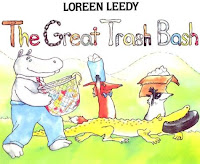School Library Journal has this to say about My Teacher is a Dinosaur and Other Prehistoric Poems, Jokes, Riddles, & Amazing Facts:
Gr 2-5–Organized chronologically, this collection zips through prehistoric times, starting about 4.5 billion years ago when “a new planet was formed.” Each page hits the highlights of a period, focusing primarily on living things. “Let’s go to the Cretaceous/ inside a time machine,/ the creatures are voracious, /excitable and mean.” The digitally drawn and painted illustrations are all captioned and include pronunciations. Varied fonts help to keep the busy pages organized so that the poetry is distinguishable from riddles, etc. An excellent time line helps put everything into perspective. An introductory note reminds readers that the dates are estimates and facts are subject to change with new discoveries. Overall the tantalizing facts and pictures in this book will stimulate readers’ curiosity.–Julie Roach, Cambridge Public Library, MA
Gr 2-5–Organized chronologically, this collection zips through prehistoric times, starting about 4.5 billion years ago when “a new planet was formed.” Each page hits the highlights of a period, focusing primarily on living things. “Let’s go to the Cretaceous/ inside a time machine,/ the creatures are voracious, /excitable and mean.” The digitally drawn and painted illustrations are all captioned and include pronunciations. Varied fonts help to keep the busy pages organized so that the poetry is distinguishable from riddles, etc. An excellent time line helps put everything into perspective. An introductory note reminds readers that the dates are estimates and facts are subject to change with new discoveries. Overall the tantalizing facts and pictures in this book will stimulate readers’ curiosity.–Julie Roach, Cambridge Public Library, MA
And here is the review from Booklist:
Gr 3-5–This colorfully illustrated book takes readers on a tour through prehistoric times. Combining poems, jokes, and riddles with tidbits of information, it opens with the formation of the earth 4.5 billion years ago; traces the arrival of various plants and animals; and concludes 150,000 years ago, when the fossil record shows that modern humans as well as woolly mammoths, mastodons, and giant ground sloths walked the earth. The verse forms vary from one double-page spread to the next, with plenty of limericks and rhymed couplets. The riddles include such child-pleasers as “Q. Why didn’t the mammoth work in the school cafeteria? A. The hairnets weren’t big enough!” Readers initially drawn to the pictures of strange creatures or the jokes may find themselves reading the captions and poems as well. Teeming with digital drawings and paintings of creatures great and small, the pages are a bit busy, but lively. Useful for its inclusion of prehistoric life before the dinosaurs, this makes a good addition to many collections.
Booklist
Booklist
November 1, 2010
And from Kirkus:
Gr 3-5—What do you get when you combine punny jokes and riddles with diamond poems and rhyming verse? When it’s from Leedy, you get a whole lot of learning (just don’t tell the kids). Her latest introduces readers to the history of the Earth and its plants and animals. Children will have no problem following the succession of life through the pages, from the beginnings of the Earth, with bacteria making oxygen and life in the sea, to the early insects, first forests and dinosaurs that covered the land. Each spread presents one topic with a poem conveying the primary information; surrounding that poem are goofy riddles, factlets and question-limericks that expand on it. The pages are unapologetically jam-packed with information, but they never overwhelm. Lots of smaller pictures make up each spread, creating a visual flow for the facts (there is a disclaimer about habitats and exact time periods). Backmatter shows a timeline from Earth’s formation to the present day. Prehistoric time was never this much fun.
Kirkus
August 15, 2010
Receiving such positive reviews from these three important publications is not easy, so yay! Previous posts about this title can be found here.








